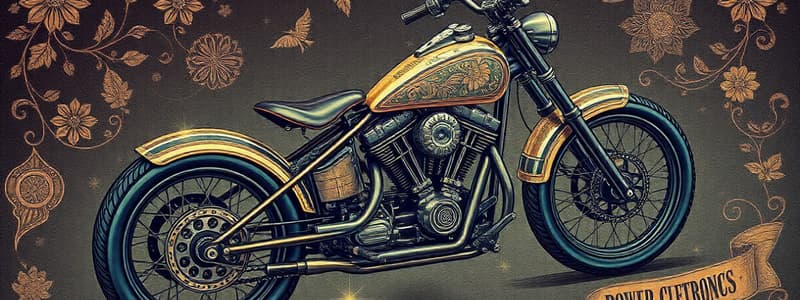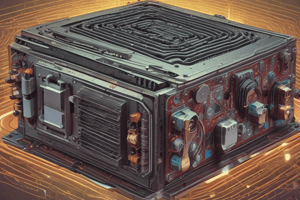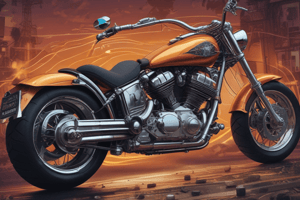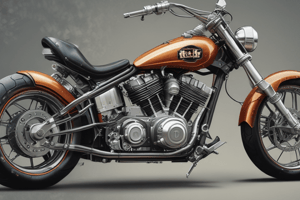Podcast
Questions and Answers
What is the primary function of chopper circuits?
What is the primary function of chopper circuits?
- To stabilize fluctuating dc voltage
- To step up fixed ac voltage
- To convert ac voltage into dc voltage
- To convert fixed dc voltage into adjustable dc voltage (correct)
Which type of chopper circuit is a two-stage conversion process?
Which type of chopper circuit is a two-stage conversion process?
- DC chopper
- Current Limit Chopper
- AC Link Chopper (correct)
- Time Ratio Chopper
Which type of control strategy is NOT used in DC choppers?
Which type of control strategy is NOT used in DC choppers?
- Time Ratio Control
- Voltage Regulation Control (correct)
- Current Limit Control
- Pulse Width Modulation Control
Why is dc to dc conversion necessary for household power supply systems?
Why is dc to dc conversion necessary for household power supply systems?
What makes DC choppers more efficient than AC Link Choppers?
What makes DC choppers more efficient than AC Link Choppers?
Which of the following describes a chopper circuit?
Which of the following describes a chopper circuit?
In chopper circuits, what does the term 'static power electronics device' imply?
In chopper circuits, what does the term 'static power electronics device' imply?
What happens in the DC Chopper circuit?
What happens in the DC Chopper circuit?
What is a common application needing adjustable dc voltage?
What is a common application needing adjustable dc voltage?
What is the main characteristic of constant frequency operation in time ratio control?
What is the main characteristic of constant frequency operation in time ratio control?
Which disadvantage is associated with variable frequency operation?
Which disadvantage is associated with variable frequency operation?
What does the current limit control method in a DC-DC converter aim to achieve?
What does the current limit control method in a DC-DC converter aim to achieve?
What is a key feature of a voltage-commutated chopper?
What is a key feature of a voltage-commutated chopper?
In forced commutation, which elements are primarily used to turn off the thyristor?
In forced commutation, which elements are primarily used to turn off the thyristor?
What effect does applying reverse voltage across a conducting thyristor have?
What effect does applying reverse voltage across a conducting thyristor have?
Which commutation technique stops conduction when the load current reaches zero?
Which commutation technique stops conduction when the load current reaches zero?
What mechanism allows a chopper to change fixed DC voltage into adjustable DC voltage?
What mechanism allows a chopper to change fixed DC voltage into adjustable DC voltage?
How is the time ratio control defined in the context of DC-DC converters?
How is the time ratio control defined in the context of DC-DC converters?
What is a significant drawback of the frequency modulation technique in DC-DC converters?
What is a significant drawback of the frequency modulation technique in DC-DC converters?
What happens when the main thyristor TM is triggered in the circuit?
What happens when the main thyristor TM is triggered in the circuit?
What occurs to the charging current ic between the capacitor voltage equaling the supply input and reaching zero?
What occurs to the charging current ic between the capacitor voltage equaling the supply input and reaching zero?
Which of the following describes the function of the diode D in the circuit?
Which of the following describes the function of the diode D in the circuit?
What is the load voltage V0 at instant t2 when the capacitor discharges through the load?
What is the load voltage V0 at instant t2 when the capacitor discharges through the load?
What is one characteristic of the step-up chopper?
What is one characteristic of the step-up chopper?
What happens during the half-cycle when the auxiliary thyristor TA is triggered?
What happens during the half-cycle when the auxiliary thyristor TA is triggered?
What assumption is made about the load current in the chopper circuit?
What assumption is made about the load current in the chopper circuit?
What is indicated by the term 'voltage commutated chopper'?
What is indicated by the term 'voltage commutated chopper'?
In which application are AC choppers typically used?
In which application are AC choppers typically used?
What is the role of the thyristor TA during the operation of the chopper?
What is the role of the thyristor TA during the operation of the chopper?
What happens to the charging current once the thyristor TA is triggered?
What happens to the charging current once the thyristor TA is triggered?
What is the load voltage V0 at instant t2 when the capacitor discharges through the load?
What is the load voltage V0 at instant t2 when the capacitor discharges through the load?
What role does the diode D play in the circuit during the charging of the capacitor?
What role does the diode D play in the circuit during the charging of the capacitor?
What occurs when the capacitor begins to charge again after the thyristor TM is turned off?
What occurs when the capacitor begins to charge again after the thyristor TM is turned off?
What assumption about the load current is made in the chopper circuit?
What assumption about the load current is made in the chopper circuit?
What primarily changes in constant frequency operation to control the output voltage?
What primarily changes in constant frequency operation to control the output voltage?
What voltage is across the capacitor when the thyristor TM is turned off?
What voltage is across the capacitor when the thyristor TM is turned off?
In a step-up chopper, what is primarily manipulated to achieve a higher output voltage?
In a step-up chopper, what is primarily manipulated to achieve a higher output voltage?
What technique uses external components like inductors to turn off a thyristor?
What technique uses external components like inductors to turn off a thyristor?
Which of the following describes the disadvantage of using variable frequency operation?
Which of the following describes the disadvantage of using variable frequency operation?
What happens to the voltage across the capacitor after it gets fully charged?
What happens to the voltage across the capacitor after it gets fully charged?
What application is a step-down chopper typically used for?
What application is a step-down chopper typically used for?
In a voltage-commutated chopper, what occurs to initiate the commutation process?
In a voltage-commutated chopper, what occurs to initiate the commutation process?
What is the maximum value of the commutation current ic when the capacitor voltage equals the supply input?
What is the maximum value of the commutation current ic when the capacitor voltage equals the supply input?
What term describes the process of turning off a thyristor in a conducting state?
What term describes the process of turning off a thyristor in a conducting state?
What allows the load current to freewheel during the OFF state of a DC-DC converter?
What allows the load current to freewheel during the OFF state of a DC-DC converter?
Which type of control utilizes duty cycle alterations to change output voltage?
Which type of control utilizes duty cycle alterations to change output voltage?
What does the term 'duty cycle' refer to in time ratio control?
What does the term 'duty cycle' refer to in time ratio control?
What characteristic makes pulse width modulation preferable over frequency modulation?
What characteristic makes pulse width modulation preferable over frequency modulation?
What is the main disadvantage noted for control strategies in DC-DC converters?
What is the main disadvantage noted for control strategies in DC-DC converters?
What is one key function of AC Link Choppers?
What is one key function of AC Link Choppers?
Which statement best describes the operation of a DC Chopper?
Which statement best describes the operation of a DC Chopper?
What is the primary efficiency advantage of a DC Chopper over an AC Link Chopper?
What is the primary efficiency advantage of a DC Chopper over an AC Link Chopper?
What is the purpose of Time Ratio Control in DC choppers?
What is the purpose of Time Ratio Control in DC choppers?
In what scenario would you likely use a chopper circuit?
In what scenario would you likely use a chopper circuit?
What effect do chopper circuits have on input DC voltage?
What effect do chopper circuits have on input DC voltage?
Which of the following accurately describes a characteristic of static power electronics devices like choppers?
Which of the following accurately describes a characteristic of static power electronics devices like choppers?
What is the main purpose of converting fixed DC power to adjustable DC power?
What is the main purpose of converting fixed DC power to adjustable DC power?
What distinguishes the control strategies of Time Ratio Control and Current Limit Control?
What distinguishes the control strategies of Time Ratio Control and Current Limit Control?
Which of the following statements is true regarding Chopper Circuits and transformers?
Which of the following statements is true regarding Chopper Circuits and transformers?
Flashcards
Chopper Circuit
Chopper Circuit
A circuit that converts a fixed DC voltage into an adjustable DC voltage.
DC Chopper
DC Chopper
A static power electronics device that converts a fixed DC voltage to a variable DC voltage, similar to an AC transformer for DC.
AC Link Chopper
AC Link Chopper
A two-stage process that converts fixed DC to adjustable DC by first inverting DC to AC, then stepping up or down the AC using a transformer, followed by rectification to DC.
DC to DC Conversion
DC to DC Conversion
Signup and view all the flashcards
Time Ratio Control
Time Ratio Control
Signup and view all the flashcards
Current Limit Control
Current Limit Control
Signup and view all the flashcards
Static Power Electronics Device
Static Power Electronics Device
Signup and view all the flashcards
Fixed DC Voltage
Fixed DC Voltage
Signup and view all the flashcards
Adjustable DC Voltage
Adjustable DC Voltage
Signup and view all the flashcards
Single-Stage Conversion
Single-Stage Conversion
Signup and view all the flashcards
Time Ratio Control
Time Ratio Control
Signup and view all the flashcards
Constant Frequency Operation
Constant Frequency Operation
Signup and view all the flashcards
Variable Frequency Operation
Variable Frequency Operation
Signup and view all the flashcards
Current Limit Control
Current Limit Control
Signup and view all the flashcards
Voltage-Commutated Chopper
Voltage-Commutated Chopper
Signup and view all the flashcards
Commutation
Commutation
Signup and view all the flashcards
Forced Commutation
Forced Commutation
Signup and view all the flashcards
Voltage Commutation
Voltage Commutation
Signup and view all the flashcards
Load Commutation
Load Commutation
Signup and view all the flashcards
DC-DC converter
DC-DC converter
Signup and view all the flashcards
Voltage Commutated Chopper
Voltage Commutated Chopper
Signup and view all the flashcards
Charging Capacitor Methods
Charging Capacitor Methods
Signup and view all the flashcards
Commutation Current (ic)
Commutation Current (ic)
Signup and view all the flashcards
Step-up Chopper
Step-up Chopper
Signup and view all the flashcards
Step-down Chopper
Step-down Chopper
Signup and view all the flashcards
AC Chopper
AC Chopper
Signup and view all the flashcards
Jones Chopper
Jones Chopper
Signup and view all the flashcards
Load Current (io)
Load Current (io)
Signup and view all the flashcards
Thyristor Switching
Thyristor Switching
Signup and view all the flashcards
Capacitor Charging Polarity
Capacitor Charging Polarity
Signup and view all the flashcards
Chopper Circuit
Chopper Circuit
Signup and view all the flashcards
DC Chopper
DC Chopper
Signup and view all the flashcards
AC Link Chopper
AC Link Chopper
Signup and view all the flashcards
DC-DC Conversion
DC-DC Conversion
Signup and view all the flashcards
Time Ratio Control
Time Ratio Control
Signup and view all the flashcards
Current Limit Control
Current Limit Control
Signup and view all the flashcards
Single-Stage Conversion
Single-Stage Conversion
Signup and view all the flashcards
Fixed DC voltage
Fixed DC voltage
Signup and view all the flashcards
Adjustable DC voltage
Adjustable DC voltage
Signup and view all the flashcards
Static power electronics device
Static power electronics device
Signup and view all the flashcards
Voltage-Commutated Chopper
Voltage-Commutated Chopper
Signup and view all the flashcards
Charging Capacitor Methods
Charging Capacitor Methods
Signup and view all the flashcards
Commutation Current (ic)
Commutation Current (ic)
Signup and view all the flashcards
Step-up Chopper
Step-up Chopper
Signup and view all the flashcards
Step-down Chopper
Step-down Chopper
Signup and view all the flashcards
AC Chopper
AC Chopper
Signup and view all the flashcards
Jones Chopper
Jones Chopper
Signup and view all the flashcards
Load Current (io)
Load Current (io)
Signup and view all the flashcards
Thyristor Switching
Thyristor Switching
Signup and view all the flashcards
Capacitor Charging Polarity
Capacitor Charging Polarity
Signup and view all the flashcards
Time Ratio Control
Time Ratio Control
Signup and view all the flashcards
Constant Frequency Operation
Constant Frequency Operation
Signup and view all the flashcards
Variable Frequency Operation
Variable Frequency Operation
Signup and view all the flashcards
Current Limit Control
Current Limit Control
Signup and view all the flashcards
Voltage-Commutated Chopper
Voltage-Commutated Chopper
Signup and view all the flashcards
Commutation
Commutation
Signup and view all the flashcards
Forced Commutation
Forced Commutation
Signup and view all the flashcards
Voltage Commutation
Voltage Commutation
Signup and view all the flashcards
Load Commutation
Load Commutation
Signup and view all the flashcards
DC-DC Converter
DC-DC Converter
Signup and view all the flashcards




